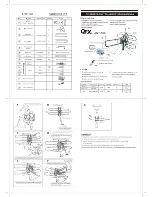
10
- - - - - - - - - - - - - - - - - - - - - - - - - - - - - - - - - - - - - - - - - - - - - - - - - - - - - - - - - - - - - - - - - - - - - - - - - - - - - - - - - - - - - - - - - - - - - - - - - - - - - -
L A B E L I T A L Y S R L
- V i a S . A l l e n d e , 5 9 – 4 1 1 2 2 M O D E N A
T E L : 0 5 9 / 3 6 2 9 9 3 F A X : 0 5 9 / 3 7 6 0 5 6
P . I V A 0 2 5 7 8 7 5 0 3 6 2 C a p i t a l e S o c i a l e 3 2 . 5 0 0 E u r o
w e b - w w w . l a b e l i t a l y . c o m e - m a i l - i n f o @ l a b e l i t a l y . c o m
What is the DC continuity measurement using an ohmmeter?
Some antennas have direct ground lightning protection. These normally measure as a DC short
between the connector’s inner and outer conductor but will be the proper 50 Ohm RF impedance .
See lightning notes in the catalog specs to determine if this antenna model should measure as an
open or a short.
Did you have the opportunity to substitute an identical antenna?
If the second antenna measures OK under the same mounting conditions, thefirst antenna is
probably defective. If the second one yields the same bad result, the problem is unlikely to be the
antenna. Perhaps the transmitter is not operating on the expected frequency.
When was the antenna installed?
It could either be new and defective or could have worked well for some time before failing. It is a
good practice for technicians to test products on receipt before transporting them to the job site.
Manufacturer's warranties cover only manufacturing defects, not damage from an improper
installation. An example would be mounting a standard antenna upside-down. This would put the
drain hole at the top where it could collect water and cause the product to fail over time
Are the antenna drain holes open?
They are placed at the bottom of the antenna for draining internal moisture. Periodic inspection of
these openings is the responsibility of the owner. They must remain clear of debris to preclude
corrosion from internal condensation. Such damage can drastically affect performance and is not
covered by warranty.
Is the antenna intermittent?
It is a good idea to shake the antenna during the above tests to ensure there are no mechanical
intermittents. Poor connections may lead to RF intermodulation products. Water entering the
antenna may lead to electrical intermittents which subside when the antenna dries out.
Notes
Match is only one indicator of antenna quality. VSWR tells us how well the product’s impedance
matches to (absorbs) a transmitters signal and is easy to measure in the field. Unfortunately
VSWR does not reveal an antenna’s efficiency (how well it radiates the signal).
This measurement (an antenna’s radiation pattern) is more difficult to perform in the field. We may
presume that match bandwidth and pattern bandwidth are equal, but this may not always be true.
Usually, substitution with an identical unit of known quality is the method of choice when a
defective product is suspected. The typical VSWR for a good antenna is 1.2:1. Although some site
engineers can declare the need for an even lower value. For example at 1.5:1 the 4.0% of the
power is reflected back, creating a 0.18 dB loss. At 1.3:1 only the 1.7% is reflected resulting in
0.07 dB loss. The performance improvement is only 0.11 dB. It is a good idea to document
performance upon installation. This is usually done by choosing a remote site and measuring the
signal level received from the transmitter. Periodic measurements at that same location will reveal
the amount of any degradation so corrective action may be taken.




























